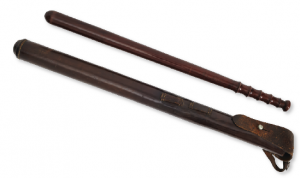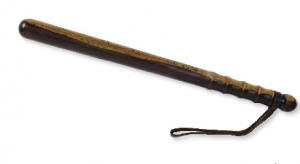Dublin Metropolitan Police batons
Published in 1913, 20th Century Social Perspectives, 20th-century / Contemporary History, Artefacts, Issue 4 (July-August 2013), Volume 21caption id=”attachment_18133″ align=”alignleft” width=”300″] Lar Joye on the weapons that made their mark on the streets of Dublin in 1913.[/caption]
Lar Joye on the weapons that made their mark on the streets of Dublin in 1913.[/caption]
‘Every afternoon a troop of policemen marched in solemn and majestic single file from the College Street police station. At regular intervals, one by one, a policeman stepped sideways from the file, adjusted his belt, looked up the street and down the street for stray criminals and condescended to the duties of his beat.’
—James Stephens, The charwoman’s daughter
The Lockout was a conflict between the employers represented by the Employers Federation who wanted to stop the rise of trade unionism in Dublin and the Irish Transport and General Workers’ Union (ITGWU). The immediate response from the local British government apparatus was to support the employers, ordering the Dublin Metropolitan Police (DMP) to defend their interests. Unlike the rest of Ireland, Dublin had its own independent unarmed police force, in contrast to the paramilitary Royal Irish Constabulary. The DMP had been created in 1836 and was closely modelled on the London Metropolitan Police but was administered from Dublin Castle. Recruits had to be less than 26 years of age and over 5ft 9in. in height. Unlike the RIC, the new recruits could work their way up through the ranks to superintendent. There was also a mounted unit based at Kevin Street Station.

The standard police baton was 48cm long, while the mounted police carried a sword and a 62cm-long baton (top) in a leather saddle-pouch. (National Museum of Ireland)
Each constable was equipped with a baton but was only allowed to use it if ‘he himself were in danger or to prevent the escape of felons’. When wielding the baton, constables were warned to use it only on the arms, back or shoulders. The serial-numbered batons were made from a single piece of turned hardwood, normally teak, and did not contain lead, as is sometimes thought. The standard police baton was 48cm long, while the mounted police carried a sword and a 62cm-long baton in a leather saddle-pouch. During the Lockout there were fifteen major riots between August 1913 and February 1914 in which the DMP baton-charged protestors. The most infamous was on Sunday 31 August, when James Larkin was arrested by Superintendent Murphy after addressing a banned meeting from the first-floor window of the Imperial Hotel (now Cleary’s department store) on O’Connell Street. In response, the police are described as going berserk; they baton-charged the crowd, many of whom were not strikers, causing c. 500 casualties. Two strikers had already died from injuries sustained as a result of a baton charge the previous night at Liberty Hall.
These events became known as ‘Bloody Sunday’ and were to be followed a year later by another Bloody Sunday, on 26 July 1914, after the Bachelor’s Walk shootings by the King’s Own Scottish Borderers. Prior to 1913, as shown in James Stephens’s The charwoman’s daughter, the DMP had been popular; after the Lockout, however, as its historian Jim Herlihy has written, ‘the credibility of the DMP was severely tarnished’. The DMP was amalgamated with the Garda Síochána in 1925. HI
Lar Joye is curator of military history at the National Museum of Ireland (Decorative Arts).
Further reading
J. Herlihy, The Dublin Metropolitan Police—a short history and genealogical guide (Dublin, 2001).
















